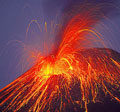 Another week, another load of tripe from Garth George in the Herald. He emerges from his sulphurous lair stirred by stories of volcanoes in Iceland to lend his weight to calls for the suspension of the Emissions Trading Scheme. He makes so many egregious errors that he not only makes himself look foolish, but also calls into question the editorial standards of the Herald. Opinion is opinion (and Garth is entitled to his) but facts are facts, and the nation’s leading newspaper should not allow him to simply invent his own.
Another week, another load of tripe from Garth George in the Herald. He emerges from his sulphurous lair stirred by stories of volcanoes in Iceland to lend his weight to calls for the suspension of the Emissions Trading Scheme. He makes so many egregious errors that he not only makes himself look foolish, but also calls into question the editorial standards of the Herald. Opinion is opinion (and Garth is entitled to his) but facts are facts, and the nation’s leading newspaper should not allow him to simply invent his own.
Let’s take a closer look…
Here’s his opening error:
…more and more evidence is available that gases such as carbon dioxide and methane have absolutely no effect on global temperatures.
What evidence would that be, one wonders, because Garth provides no clue. I haven’t heard of any major revisions in basic physics that would allow greenhouse gases not to warm the planet. I suspect Garth is just making stuff up, interviewing his typewriter (which, for all I know, may be about to win a Nobel prize for rewriting quantum physics).
I suspect that the eruption of Mt Eyjafjallajokull in Iceland shot more gases into the atmosphere in five minutes than New Zealand would in five years.
No need for suspicion. The figures are available, and even Garth could have Googled an answer to his rhetorical question. Leo Hickman at the Guardian has done the digging: Eyjafjallajökull has been emitting somewhere in the range of 150-300,000 tonnes of CO2 per day. New Zealand, on the other hand, emitted 74.7 million tonnes of CO2e in 2008 according to the latest MfE report. Garth could have argued that Eyjafjallajökull’s peak daily emissions were about the same as New Zealand’s, but they were also being more than offset by the cancellation of so many long distance flights.
The increasing scepticism over global warming throughout the world is not surprising after the shocking sub-zero weather which created chaos all over Britain, throughout Europe and in the United States in the depth of their winter.
It was the fourth warmest winter since records began.
There is increasing scepticism here, too, after one of the coldest winters in decades, which started early and finished late, afflicted much of New Zealand.
Wrong. New Zealand’s winter started early, and was quite cold, but it also ended early and August was the warmest in the record.
But the deception continues among the global warming scaremongers.
The chutzpah is breathtaking. A Biblical phrase about logs and eyes springs to mind.
Climate has been in a constant state of flux since God created the heavens and the land and the sea and placed the sun and the moon in their orbits.
When was that, Garth?
And I am persuaded absolutely that it is the sun, not the harmless, essential trace gas carbon dioxide, that drives climate change. So our emissions trading scheme will not just be a colossal waste of time and effort but an unaffordable waste of money.
Garth’s absolute certainty is ridiculously unpersuasive, based as it is on shoddy research and made-up “facts”. The Herald, if it wishes to retain any vestige of credibility in its opinion section, should apologise for foisting such ignorant and ill-informed ramblings on its readers.
Like this:
Like Loading...
 Back in April, when Eyjafjallajökull in Iceland was erupting and causing much disruption to air travel in Europe and the North Atlantic, there was some concern that the volcano’s ash and aerosols could cause global cooling. As I said at the time, there was little chance of that happening because volcanoes need to be near the equator to cause global cooling events. However, we now we have an eruption in Indonesia that has the potential to cause a noticeable global cooling. Merapi is Indonesia’s most active volcano, and the eruptive sequence which began at the end of October has already killed at least 153 people and emitted a considerable amount of sulfate aerosols as this NASA Earth Observatory image shows:
Back in April, when Eyjafjallajökull in Iceland was erupting and causing much disruption to air travel in Europe and the North Atlantic, there was some concern that the volcano’s ash and aerosols could cause global cooling. As I said at the time, there was little chance of that happening because volcanoes need to be near the equator to cause global cooling events. However, we now we have an eruption in Indonesia that has the potential to cause a noticeable global cooling. Merapi is Indonesia’s most active volcano, and the eruptive sequence which began at the end of October has already killed at least 153 people and emitted a considerable amount of sulfate aerosols as this NASA Earth Observatory image shows:

 Another week,
Another week, 
